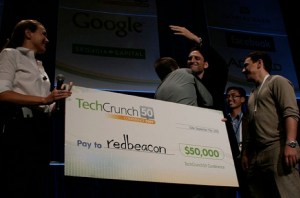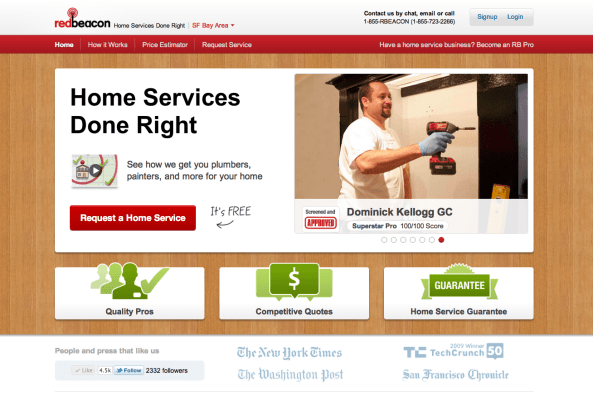I’ve been on a journey through the past as Disrupt NYC (tickets here) draws closer, sifting through past Disrupt and TC50 startups with the hopes of getting a clear update on the accomplishments, the trials, and the milestones between then and now. The stories have been amazing, but one of the most incredible tales of growth and success I’ve yet to hear lies with Redbeacon.
The company first won top prize at TC50 in 2009, and has since gone on to raise a $7.4 million round led by Mayfield Fund and Venrock (purely bootstrapped up until then), and ultimately found themselves in the midst of an acquisition by Home Depot.
I spoke with co-founders Aaron Lee and Yaron Binur to hear the impressive tale straight from the horses’ mouths.
Here’s the interview in its entirety:
TechCrunch: So tell me what’s happened between TC50 and now? What was the TC50 experience like?
Redbeacon: Well, the interesting part of TC50 is that you have to launch on stage. We had an awesome product and we were excited but no one had used it up until that moment.
We launched in the Bay Area and spent the next 8 months iterating. Even though we launched at TC50 with no users beforehand, we started collecting data which was extremely useful. We skipped the whole angel round with the small amount of money we could raise, including our TC50 prize, and then eventually raised $7.4 million.
I think there were three factors that went into getting that $7.4M round: our willingness to put in our own money, the great data we were generating, and our win at TC50.
![]() The experience of launching our product on stage with TechCrunch and getting interest and appetite from investors made that first round of funding a lot easier to get. It opened up a lot of doors for us. When you have all those things come together — great data, a great team, a great product, and TechCrunch — it makes that round easy to raise and it makes it easy to get a lot out of it.
The experience of launching our product on stage with TechCrunch and getting interest and appetite from investors made that first round of funding a lot easier to get. It opened up a lot of doors for us. When you have all those things come together — great data, a great team, a great product, and TechCrunch — it makes that round easy to raise and it makes it easy to get a lot out of it.
TC: Did you feel like, after TC50, you kind of had your choice when it came to shopping for investors?
Redbeacon: Absolutely. We were very picky and felt like we had a lot of choices with investors. Our investors were rock solid. Without them, the acquisition with Home Depot would have been impossible.
Once we got that money, up until then we only had three or four people in the company. We could then finally grow the team and grow geographically. We went from the Bay Area to 11 different metros, and as we scaled and grew we arrived at one of the most important things we could learn.
With the growth of our team and product we needed to focus on new products. We had originally launched a very generic product. All services. What we saw from the data as we scaled was that 80 percent of our requests were for home services, and not the other categories.
As a consumer, they didn’t understand the idea of local services. They couldn’t make a connection between wedding planners and roofers. By focusing on home services, we had a clearer brand and could specialize our product in useful ways. Redbeacon then became all about my home or maintaining my home.
That was obviously a huge shift for us. From that point we started seeing a lot of traction and growth. We started introducing key features that were only possible with that focus.
We also went mobile, which was huge, both on the consumer and the provider side.
We saw huge growth on the revenue side throughout 2011. And in January of this year, Home Depot understood the opportunity and that the space is huge. They also saw that Redbeacon is best to take it over. One thing you can see in the marketplace is that a younger generation is moving from DIY to do it for me.
Since the acquisition in January, we’re already scaling and leveraging the business. It’s integrated with the shopping experience at Home Depot, and we have a lot of interesting things in the pipeline too.
TC: One thing I notice during Disrupt is that the Q&A is particularly brutal. A company’s entire stance can quickly be brought down by an Arrington or a Wilson or a Mayer. How did you guys feel about the Q&A experience, and do you think that session might have actually improved your product in the early stages?
Redbeacon: We learned three main things from the Q&A. The first was the chicken and the egg rule. We had a two-sided marketplace and it’s hard to bootstrap and scale the business keeping things even on both sides. That was a big worry for them. But that put it in context in a way that was really useful: we learned that the provider side is much easier than the consumer side. They list themselves, we know how to get a hold of them, so if we come to them with real jobs and work they’re very interested in engaging.
That session helped us identify that issue and while we spent eight months iterating we were trying to figure out how to balance out both sides before expanding.
Another thing that came out of the Q&A was going mobile. This was back in 2009, so the idea was still relatively new, but it turned out to be key. Our engagement on mobile is huge.
The last thing we learned was how we should roll out and scale: should it be city by city, nationally by one vertical? We tested out a lot of different ways, but a local business can’t go national in one day. It was useful to hear their concern about that and think through it.
TC: We have a ton of entrepreneurs and hackers heading out to New York today and tomorrow. You’ve been there before; so what advice would you give to these guys getting ready to launch on the Disrupt stage?
 Redbeacon: Along with having experience at Disrupt, I’m also an angel investor and a mentor at 500Startups. A few things to learn is to keep your product and do less rather than more. Launch and iterate quickly. And do tons of interviews early on. Understand how people are using your product and run lots of tests. Don’t make it a stealth product because there’s not enough feedback that way.
Redbeacon: Along with having experience at Disrupt, I’m also an angel investor and a mentor at 500Startups. A few things to learn is to keep your product and do less rather than more. Launch and iterate quickly. And do tons of interviews early on. Understand how people are using your product and run lots of tests. Don’t make it a stealth product because there’s not enough feedback that way.
It’s also important to remember that raising money is great but it’s a means to an end. Stay focused on the product and the users.
TC: So generally speaking, how do you think that Disrupt helped build Redbeacon?
Redbeacon: I think there are four main ways. It helped us raise money, as I said before. It also helps early on with business development. It’s hard for large companies to trust you when you’re running on your own money. But having won Disrupt opened doors and gave us credibility. Some of our early partnerships told us that after hearing about us on TechCrunch, it instilled a lot of confidence in the team and the product.
Disrupt also helped us with media relations, not only with TechCrunch but across the board. And it also helped with hiring and recruiting. People were excited to be a part of a team that had won at TC50.
Disrupt NYC is set to be one of our biggest shows yet, with returns from Michael Arrington and MG Siegler, along with a variety of big names like Marissa Mayer, Sarah Tavel, Fred Wilson, and David Lee and more. It’s going to be huge.
If you’re interested in checking out Disrupt and/or the Hackathon yourself, tickets are still on sale here and info on the Hackathon can be found here. Companies who want to join the Battleground can apply for the last remaining spots in Startup Alley. You can find the full agenda here.
